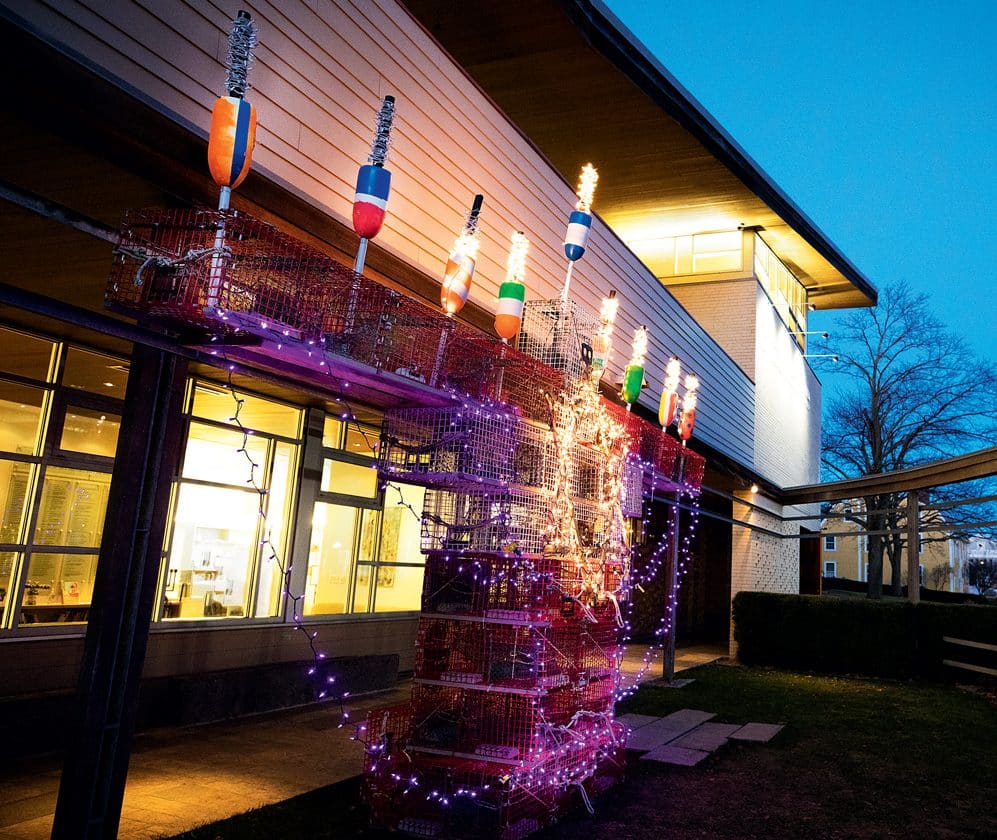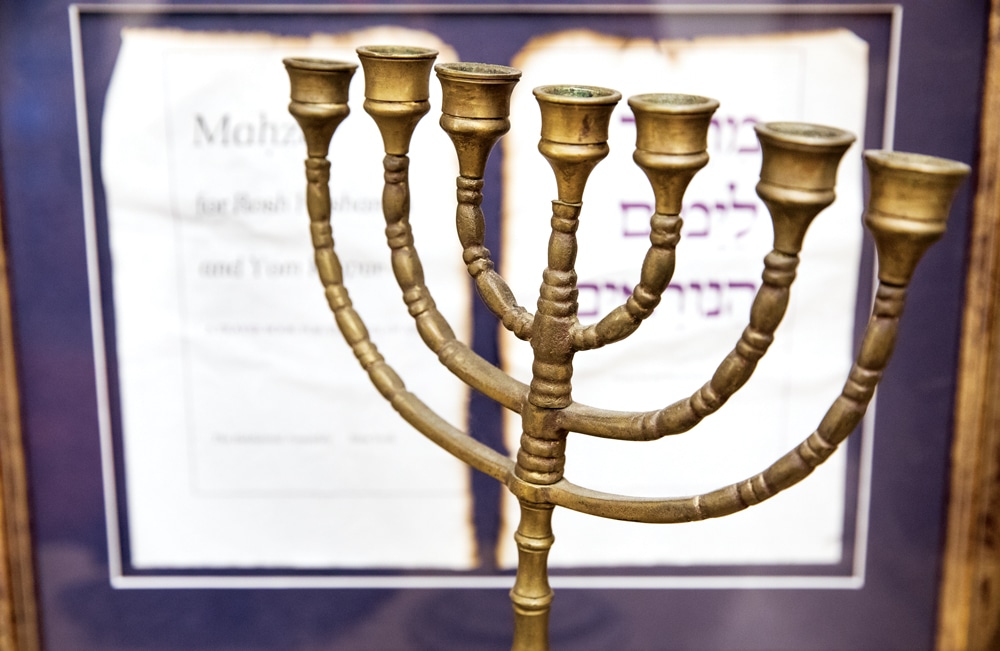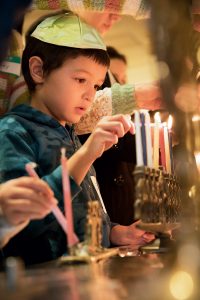A Lobster Trap Menorah Shines in Gloucester, Massachusetts
From the ashes of a fire that destroyed a Massachusetts city’s lone synagogue arose a symbol of community across different faiths.

Religious tradition and maritime heritage come together in the lobster trap menorah of Temple Ahavat Achim, a synagogue in the heart of America’s oldest seaport.
Photo Credit : Joel LainoDecember 14, 2007. Midnight.
Barry Pett repeats the date and time of the fire that burned Temple Ahavat Achim to the ground as if the memory perpetually hovers on the edge of his consciousness. The devastating, fast-moving blaze in Gloucester, Massachusetts, had started at an apartment building next door, where it took the life of one resident and left dozens more homeless. A Gloucester native, Pett had lived half a block from Temple Ahavat Achim on Middle Street for more than two decades. “I saw the fire,” he says of the billowing flames that rose several stories into a frigid night sky. “I was watching out my window.”
Pett is a semi-retired businessman and president of the community nonprofit Gloucester Fund. He is tall with angular shoulders and a wispy white goatee on a smooth, youthful face. When Pett graduated from Gloucester High School 50 years ago, he was the only Jewish boy in a class of nearly 350. There were just a few dozen Jewish families in the city then, about half in the downtown area near the temple. “There wasn’t even a Hebrew school,” he says.

Photo Credit : Joel Laino
As we talk, he’s looking transfixed, staring into the candlelight of a gorgeous silver menorah. It had once belonged to another Gloucesterite, Walworth Barbour, the late U.S. ambassador to Israel, who had received it as a personal gift from Prime Minister Golda Meir. The menorah was in turn bequeathed to Pett, who had been Barbour’s friend and driver, and beginning in the 1980s it was loaned to the temple. That it had escaped the 2007 fire seems to mirror the miracle of the season and the resilience of the congregation itself.
On this cold December night, I had come to the rebuilt Temple Ahavat Achim in Gloucester, the sole synagogue on Cape Ann, for none of this. It is the first night of Hanukkah and the fifth annual lighting of a whimsical menorah made from borrowed lobster pots. Eight buoys sprout from the top of the 14-by-20-foot structure, their dowel ends wrapped with LED strings.
The concept behind the menorah is simple: to connect to the greater community through its fishing heritage. Years earlier, a towering Christmas tree built from lobster pots had drawn crowds to its Main Street location, at the police station. The idea to construct a complementary menorah is credited to a local schoolteacher, Michael Gerber, but the execution was left to others in the congregation. That group included the late writer and storyteller Jim Dowd, who narrated the inaugural 2014 undertaking in a series of entertaining posts and videos. “We checked with the Conservative Council of Judaism if we could have lobster traps. Obviously lobsters are not kosher, but lobster traps, turn out, are just fine,” he says in one video, flashing an impish “go figure” grin.
The first year, the menorah builders borrowed the wrong pots, causing police to respond to the waterfront for the head-scratching case of 25 missing lobster traps. Once the mystery was cleared up, the pots’ owner told the organizers not to bother returning them and to go ahead with the project. As word about what was happening at Temple Ahavat Achim got out around town, people showed up in force. A time-lapse video of the construction got hits across the country. “We were trending,” says Rabbi Steven Lewis. “The publicizing of the mitzvah [good deed] went well beyond what any of us could have expected.”
During the lighting ceremony that first year, 2014, Lewis repeated two origin stories in front of a crowd of multifaith observers, that of the new lighted creation and of the ancient Jews. “The unique and innovative design [of the lobster trap menorah] is a statement about our aspiration to live creative, authentic, and deeply Jewish lives that are an organic part of this amazing city,” he said. He scarcely needed to allude to the other thing on everyone’s mind: the rising of the new synagogue behind them. The only structural items to survive the 2007 fire were the large mahogany entry doors that responding firefighters had broken through and a few two-ton slabs of Cape Ann granite, now serving as outdoor benches.
———
The fire started at midnight in the four-story Lorraine Apartments building and grew to eight alarms, drawing firefighters from as far away as New Hampshire. It took most of the night to contain the blaze, which would continue to smolder for five days. The firefighters brought all the occupants to safety except one: They couldn’t reach Robert Taylor, a 70-year-old longtime resident on the third floor.
Next door, the temple was a total loss. The heat was so intense it had melted metal. At the time, the building was 179 years old, having served first as a church and then, beginning in 1951, as a synagogue.
Saturday morning after the fire, the nearby Unitarian Universalist church invited the displaced members of Temple Ahavat Achim to share their place of worship. Dramatically, midservice, several firefighters walked into the sanctuary and delivered the Hebrew books and prayer shawls they had recovered.
Dowd recounted the tale in a 2015 open-mic storytelling night that was themed around heroes. “We were saying … the Kaddish, the prayer for the dead, for the man who lost his life in the apartment next door, when all of sudden the doors opened and streams of light come pouring in [with] the firefighters.” They were in their turnout coats, and “you smelled the smoke on them,” he said. They couldn’t save the temple’s five Torahs, but in this overwhelming emotional moment a Jewish member kissed his tallith, or prayer shawl, and in the absence of the Torah to touch, he touched one of the firefighters with it. Then another did the same.
At some point, Pett, who was also in attendance, noticed his silver menorah. It had been not in the burning temple but in the Unitarian Universalist church, where it had been used for a multifaith service a few days before. The menorah was supposed to have been returned to the temple on Friday; the oversight was its salvation. “I assumed that it had melted down like everything else,” Pett says. “At the time, I had no idea how it survived.”

Photo Credit : Joel Laino
From the start, the Temple Ahavat Achim congregation intended to rebuild, but where and how were real questions. Some members wanted to build away from the congested city center, so they could expand and provide parking. Ultimately, they decided to stay downtown, since being in the heart of Gloucester—even as part of a minority community—meant being neither symbolically nor geographically on the outskirts.
The fund-raising goal for the temple was reached quickly, with $2 million coming from one family alone. While the new structure was going up, the members were offered the use of area churches for Saturday services and Hebrew school. In 2011, the new temple was officially opened. The architectural details were stunning: a high-ceilinged sanctuary with gleaming wood floors, a handsome balcony, and an entryway garden terrace. Steel beams supported the 12,000-square-foot structure. Viewed from a certain angle across the street, the roof line at twilight appeared like the jutting prow of a ship on a following sea. A pilothouse, too, was easy to imagine, as the temple’s seamless bank of eastern-facing windows projected light into the darkness.
———
For the lighting of the lobster trap menorah in 2018, two Gloucester police officers were requested. A big crowd was expected, and the security—the first ever for the ceremony—was an unfortunate reflection of the times. An increasing number of anti-Semitic incidents were being reported across the country. Racist graffiti had been scrawled at a synagogue a few miles away, in Peabody. And just six weeks earlier, a shooting at a Pittsburgh synagogue had left 11 dead and six injured, not counting the gunman.

Photo Credit : Joel Laino
In response to the Pittsburgh massacre, Rabbi Lewis had called for an open community assembly—and the turnout was overwhelming. It was an affirmation, if anybody needed further proof, of the congregation’s decision to rebuild in the “shadow of City Hall” and remain in the center of the community. There had been talk of not holding a public lighting of the menorah, Lewis says, but the consensus was to be visible and resolute. To stand as tall as ever. The ceremony would go on.
It wasn’t the longest night of the year, but the positioning of the moon meant it was the darkest. Lewis knew the crowd was eagerly awaiting the lighting and the blessing; however, first he needed to share an email he had received earlier that day, from a friend working in Baghdad for the U.S. State Department. “A woman on my team invited the few remaining Iraqi Jews to the embassy tonight and will light Hanukkah candles,” the friend wrote. “All of the Iraqi guests were very old, and one told me she had not been to a Hanukkah celebration outside her immediate circle for several decades.” So, said Lewis, from the Talmud written in Babylon to the Jews in Iraq at the U.S. embassy lighting Hanukkah candles for the first time in a public event, “this is a time where we need light in darkness, and Hanukkah is a festival of light in darkness.”
The rabbi led the singing of two blessings, and then the electric light show flashed on. There were eight candles and, in purple, a towering candelabra; outlined in white was a huge Star of David. The crowd cheered and lingered with children for pictures. Half an hour later, all were inside the synagogue for the lighting of family menorahs displayed on a long foil-lined table. A single match was used to light a communal candle, the shamash. It was exchanged from family to family until all the candles were burning.
Pett’s menorah was in the center. There are 190 member families now, and a roughly $1 million endowment has been amassed for the educational center and Hebrew school. Pett is still not sure why Barbour wanted him to have this special gift, but he never tires of seeing it lighted with all the others—the lobster trap menorah included.
Editor’s note: Some archival quotes in this story originated in either a 2015 Cape Ann TV–produced video or a Gloucester Writers Center Fish Tales video called “Heroines & Heroes.”

